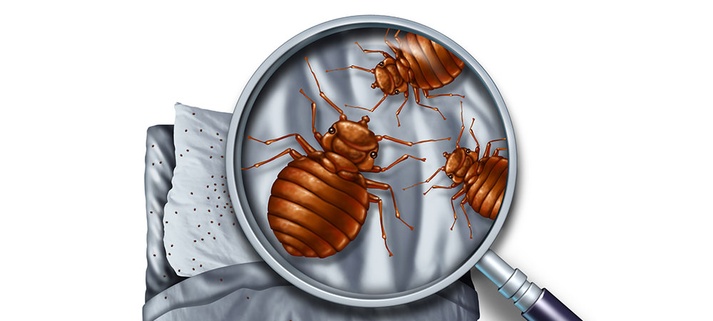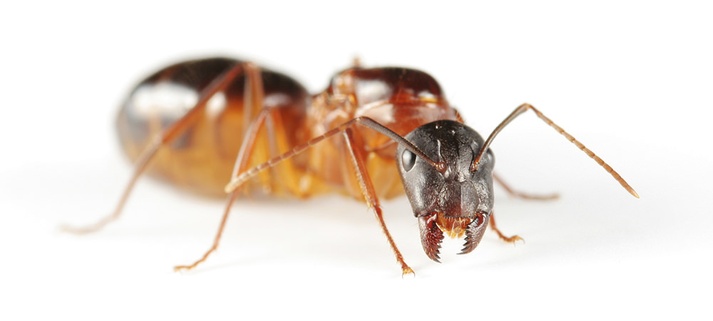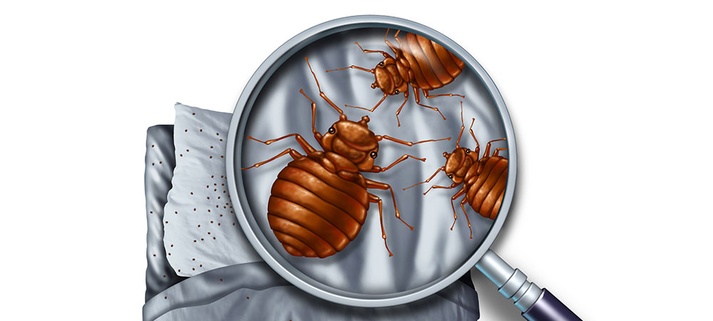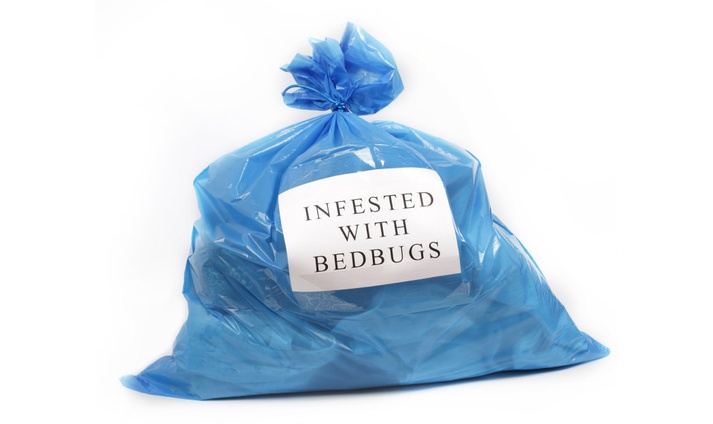Pest Profiles - Guests You Do Not Want Coming Over For Dinner: The Carpenter Ant

Like the FBI’s Most Wanted list, carpenter ants, cockroaches, and bed bugs are easily the three most hated and hunted of urban insect species. Each one has its own habits and food sources. Understanding them can help you know how to keep them out of your home.
Carpenter Ants – Considered the most common household insect in North America, carpenter ants live in the walls, floors, and trees of our properties. Black and red in color, carpenter ants can be up to an inch long.
These ants live in rotten wood, tunneling their way very efficiently around. They are sometimes thought of as being like termites, but they don’t eat the wood. In fact, they are great at building perfectly rounded tunnels and rooms, leaving no wood shavings behind at all.
Carpenter ants have to have a consistent source of moisture. In the wild, this will be under a branch of a tree. In a home, this can be a moist area like an attic or a crawlspace.
Because they don’t eat wood, they will look for other foods. They particularly love sweets.
Prevention is not too difficult. Keep vines and shrubs away from your home. Pay attention to what is on or in the firewood you bring into the house. Watch for holes or rotting along the foundation, around skylights, near door frames, or even near telephone wires.
A pest control professional will look for the nest and figure out how large it is. Eliminating the nest requires destroying the whole nest at once.
The Anchor Pest Control team can make sure that you never have an infestation of carpenter ants in the first place. We can also help you to eliminate an infestation quickly and completely if you have one. Call us today for an inspection or preventative maintenance service!
Did You Know These Things About Bed Bugs?

In our over-sterilized and hand sanitizer world, bed bugs are back with a vengeance. One of Europe’s least desirable imports, bed bugs come over with the first American colonists. Over the centuries, bed bugs have built up a tolerance to pesticides of all kinds.
Did You Know? Bed bugs are not only found in beds.
Bed bugs can be everywhere. From the bedroom to the couch to the office, any place where there are small seams for them to hide in.
Did You Know? Bed bugs like your CO2.
Bed bugs, like mosquitoes and more bugs, are attracted to carbon dioxide. It is the exhaling of CO2 that tells the little critters where you are.
Did You Know? It only takes one mother to raise a village.
One adult female can lay 7 eggs per day for an entire year. That’s a lot of bugs and each of those bugs matures very quickly and starts their own little families.
Did You Know? They can’t see well, but they know you’re there.
Bed bugs can sense your breathing from 4 to 6 feet away. They are like some creepy horror movie.
Did You Know? They don’t need to eat.
Like a supermodel, these little beasts can live for over a year without a meal. That means that leaving the house or cutting off their food supply doesn’t really solve the problem.
Did You Know? You are the fridge.
You and your family are the late night snack for the bed bugs. Bed bugs are nocturnal feeders. While they will eat during the day, they primarily feed under cover of darkness.
There really is only one way to eliminate bed bugs: You have to hire a professional to exterminate these little monsters. They are so resistant to nearly everything that humans try that only a pro can keep up with the latest techniques.
NJ Commercial Bed Bug Removal - Every Business Needs a Plan in Place (Risk Management Plan)

Bed bugs are quickly becoming a serious issue in the US and around the world. They come in with anyone at any time. They aren’t not easily detected and they are difficult to get rid of. The best way for a business to protect itself is to be proactive. Get ahead of bed bugs by having a plan to prevent an infestation.
A great bed bug plan involves attacking the problem with three separate steps, which we will cover in 3 posts.
Step 1: The Risk Management Plan
Have a real risk management plan – Make sure that employees know what to do if a customer comes to them and says that they have been bitten. They should know what to write down, what to say and how to move forward.
Companies need to have a conversation with their legal departments and providers to make sure that everyone is on the same page of how to handle the situation.
Employees need to learn to be observant and need to be trained what to look for. Every employee can be the eyes and ears of the owners, helping to stay out in front of potential problems.
Review insurances and vendor’s insurances to make sure that everyone is covered in case of an infestation.
Take a look at the pest control provider’s contract In it there should be information on what their responsibility is. It will also help to define what you are expected to do for prevention and in case of an infestation.
Make sure that you have a policy regarding bed bug infestations. This should include non-disclosure, accountability and what the company will do the assist them with eliminating the problem in their own home. (If it’s in their house, it will be back in your business the next day.)
NJ Commercial Bed Bug Removal - Every Business Needs a Plan in Place (Employee Education)

A business’ plan for dealing with bed bugs can be as important as a fire plan – and even more likely to be needed.
The first part talked about the importance of a detailed risk management plan. In this second portion, we will review how to train employees, expanding on one of the most important portions of the risk management plan.
Step 2: Employee Education
Making sure that your employee know what to look for and know whom to tell can be a large part of making sure that a small infestation doesn’t become a business destroying liability.
Check with your pest control provider. Many of them offer trainings for you and for your staff. This training will involve teaching everyone the symptoms and the course of action if pests are discovered.
Teaching staff to be vigilant is a large part of preventing bed bug from getting a foothold. One of the most important things for them to understand is the idea that if there are bugs at work, it’s only a matter time before they are at home too.
Maintenance staff can be the first line of active defense. Having the maintenance team spot check the facility every day will ensure that undistracted eyes are watching for bed bugs. Also making sure that the checks are entirely randomized will help to keep the team from checking the easiest space and force them to keep an eye on the entire building.
Give the entire staff the ability to call the pest service provider. They should definitely call management next, but entrust your pest control company to know when to come out and make it part of your contract that they will handle every call without outrageous expenses.
Keep reminder posters in the break rooms and other employee only spaces to remind staff of the symptoms of an infestation. While this might pose a public relations concern, it is easier to show that you are vigilant than to get rid of the stigma having bed bug in your business.
Your staff and employees are the first line of defense for your business against a bed bug infestation. Having their assistance and training them well will make all the difference in the crucial time period when the first bugs show up and when you have a full blown infestation.
NJ Hotel Bed Bug Control: The Most Expensive Bug In America

$8,000 to $10,000 – That’s how much the average out of court settlement of a bed bug victim. That’s how much a hotel could pay out to a single person that can prove that they got the bed bugs from one establishment.
That’s only the beginning: How much will it cost if the hotel receives a reputation for having bed bugs. Thousands of establishments have been ruined by online reviews warning people away. In fact, there are now databases dedicated exclusively to tracking what places have bed bugs.
Unchecked, an infestation can lead to 13,000 or more bed bugs. That’s far more than any one individual can ever handle. One female insect can lay thousands of eggs in a single year and they live longer than most insects. They can even live for over a year without food.
What can you do?
- Get supplemental insurance that will protect you from that liabilities of bed bugs. This type of insurance might seem frivolous until the first time it saves you from having to open your wallet.
- Get a qualified and trained exterminator to check your property regularly. They might not be able to keep the bugs out, but they can definitely keep them from getting a foothold in your business.
- Don’t be cheap. Sometimes, after being told that they have a problem, business owners will ask for the least expensive solution. This is not the time to ask for what is cheap, but what is effective. The cost to you in the long run could destroy your business.
Bed bugs are an insidious and vicious little problem. Every customer, every client, every visitor can bring them in. They ride along on clothing, luggage, in vehicles, even in the seams of clothes.
Don’t let tiny bugs take down your business. Be proactive and you can prevent them from being more than simply a nuisance.
What to do if you think you have BED BUGS!

Don’t begin sleeping in another bed, or on the sofa. Do not go to stay with someone else. The bugs may follow you, and then it will be much harder to get rid of them. Staying outside of your home means the bugs may become dormant. They can live without feeding for up to 18 months. When you come back, they can begin biting you again. So staying in your home during treatment, and sleeping in your usual bed, is the way to kill bed bugs. Once you are being treated, you must remain in the bed–you are the bait, attracting bugs to the poison and their deaths. If you isolate the bed, they need not bite you.
Do save any bed bugs you find. You may need to show them to landlords, pest control professionals, and so on. Pick up with clear packing tape, and tape the specimen(s) to an index card. Don’t assume you’ll see lots of them, most people don’t.
Do rule out other possible conditions, like folliculitis, scabies, and bites from other insects.. Be warned, though, that many of us are told by doctors that we do not have bed bugs, and later find they are wrong. Many of them have never seen bed bug bites, or have seen only some patients with them. Bites can range from large welts to small red bumps, to scabby pimple-type bumps.
Don’t start buying a load of chemicals and treating yourself. Remember, pesticides have different qualities (repellents, contact killers, residual killers, growth regulators, etc.) Bed bugs are probably the most complicated pests you’ve ever encountered at home. If you start spraying pesticides, you may disperse the bugs, and the professionals may have trouble treating them. You may spread them around your home.
Do not, absolutely do not release a fogger or bug bomb. Do not allow your landlord to do so. Do not allow a so-called exterminator to do so. Bug bombs / foggers do not work for bed bugs, and in fact, will spread them. Your problem will be magnified.
Do start dealing with your clothing and linens. Though you should not simply seal your possessions in bags, it is probably a good idea to start working on clothing and bedding, since the PCO is going to tell you to do this, and it takes time. You should take clothing and other items, wash them in a machine on hot 160 degrees, and dry them on hot for 1-2 hours. Remember, driers vary as to their strength and how long they take with what size of load. My personal method is that items should at least be dried on hot for 20 minutes after they appear to be fully dry and very hot. If you want to be cautious, go for two hours on hot. Dry cleaning is okay too. Keep in mind that pillows, comforters, down coats, and other thick items may take longer. Here’s the key: after washing and drying, bag items in sealed, airtight bags, and do not remove them until use.
Don’t assume bed bugs are only in your bed. While bed frames and mattresses and headboards are the most likely location for bed bugs, they can and do often hide out in sofas and other soft furniture, electrical sockets (behind plates), light fixtures, baseboards, floor crevices, and other crevices in the bedroom and living room. Bed bugs are occasionally found in kitchens and bathrooms. This should not make you panic: most cases, especially smaller ones, are quite concentrated, usually 10-20 feet from where people sleep (or where they sit for extended periods). However, if a PCO tells you bed bugs are not found in living rooms, realize that many Bed bugs have infested sofas, computer chairs, and so on. Don’t believe that bed bugs only bite at night. They prefer a sleeping, stationary host who is fast asleep. But if they’re hungry, they’ll take what they can get. You can be bitten while in a chair, awake.






